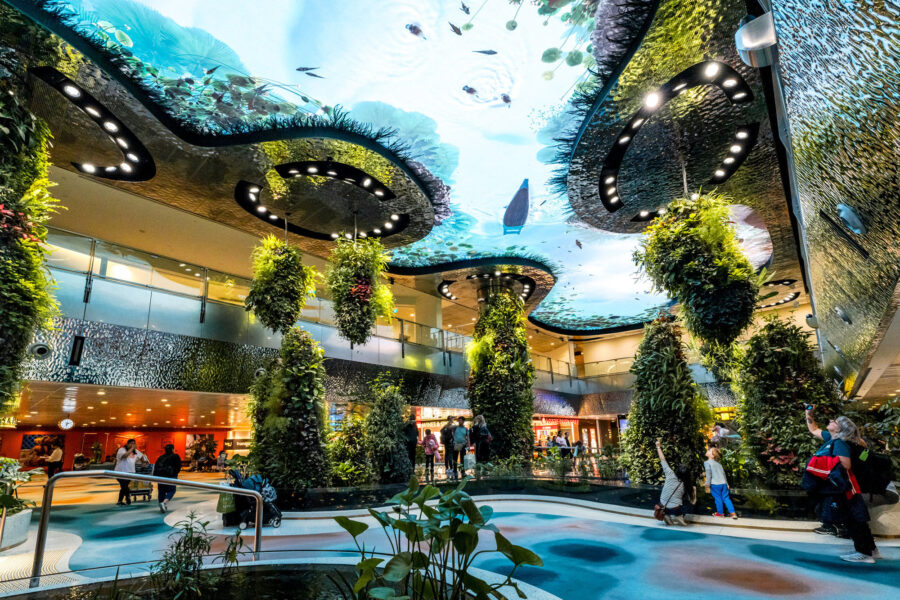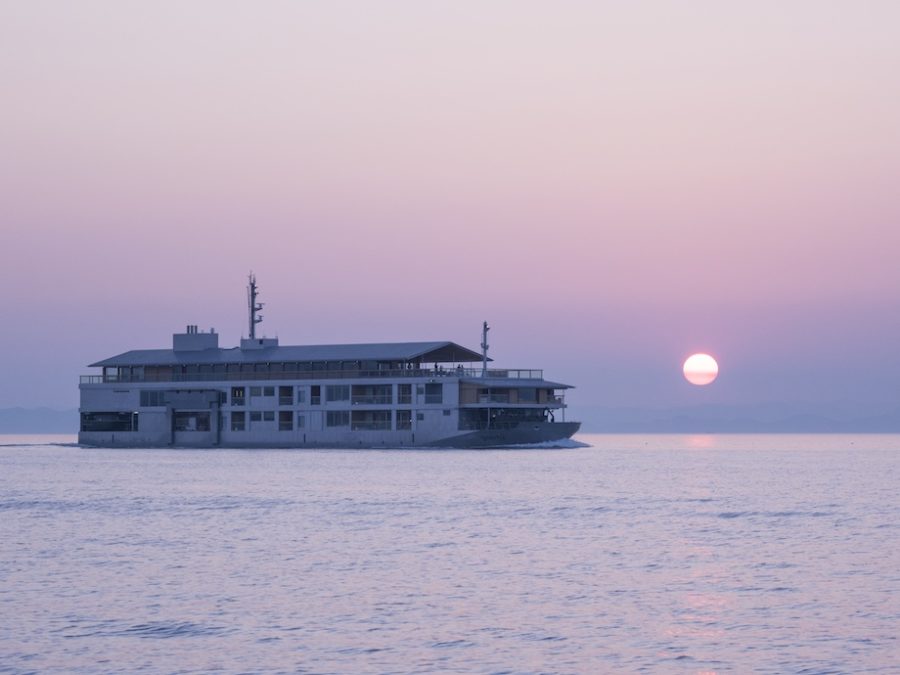
CULTURE


Aerial view ©2021 IN BETWEEN / GOA
〈謇里アートセンター(Jianli Art Center)〉と旧市街再生プロジェクトは、中国の旧市街のもつ伝統とダイナミックな新しさを併せ持つ、歴史的建造物を保存するとともに現代に活かすための取り組みです。
「都市の美しさを創造し、社会に貢献する」という企業理念を掲げる、中国の設計事務所GOA(Group of Architects)が設計しました。
(以下、GOAから提供されたプレスキットのテキストの抄訳)

West façade © 2021 IN BETWEEN / GOA
都市の歴史と文化が絶えず進化している中で、歴史的建造物の保存・再生は、新しい時代の精神とビジネス形態を融合させ、活気に満ちた持続可能な都市空間を構築する必要がある。
南通市海門区にある長楽は、清朝末期から中華民国初期の時代における重要な実業家、政治指導者、教育者である張謇(ちょうけん、1853-1926)の故郷である。
中国の大手不動産開発企業である中南グループが進める旧市街再生プロジェクトは、長楽の旧市街を「謇里(Jianli:張謇の故郷の意)」と改名し、張謇の精神に基づいて改修することを目的としている。GOAはプロジェクト全体のマスタープランと、プロジェクトの核となる旧大通りのゲートウェイとして機能する〈謇里アートセンター〉の設計を担当した。

View across the river ©2021 IN BETWEEN / GOA
乾隆帝(けんりゅうてい、1735 -1796)の時代に建設された長楽旧市街のメインストリートは、東西に300m以上伸びる石畳が特徴的な通りである。アートセンターはその東端に位置し、アートセンターの北側には築100年になる木造建築「旧長楽町物資販売協同組合」が保存されている。
新たな建築は、小さな歴史的保存建築物とどのように調和し共存するか。そして、 文化・観光機能を地域の文化的アイデンティティと融合させ、帰属意識を呼び起こしながら、張謇の「古い慣習を変え、新しい慣習を築く」という精神をどのように受け継ぐか、といった課題から設計はスタートした。

Site map © 2021 IN BETWEEN / GOA
伝統的な住まいのスタイルから継承する建築と自然の融合
〈謇里アートセンター〉は、長江河口北岸の重慶地区の特徴である「堀に囲まれた家」という住居のプロトタイプを参考に、水辺に建てられている。その名の通り、「堀に囲まれた家」とは家の周囲に堀を巡らせ、小さな橋が出入り口となっている住居形態である。
堀の水は、飲用、洗濯、灌漑、消火などに使われるとともに、防犯の役割も果たす。農村の近代化とともに風景は変化してきたが、家の周りの堀や小さな橋は、伝統の印として今も地域の家に残されている。

Traditional dwelling prototype of the region ©GOA

East view © 2021 IN BETWEEN / GOA
このプロジェクトでは「堀」の考え方を継承し、周囲の水系を残しながら、アートセンターの南側と東側に新たに橋を架けることで、対岸とのつながりを構築した。既存の木造建築のスケールを尊重しつつ、植物と水辺で構成されるランドスケープをデザインすることで、伝統的な空間レイアウトを継承しつつ、地域文化との対話を実現している。
このアートセンターには鉄骨造を採用し、柱とカーテンウォールの垂直ブレースを一体とすることで、開放的な室内空間を形成している。分棟とした建築の間には細長い中庭を設け、日差しや庭の眺めを室内に取り込んでいる。ガラス面と壁面を交互に配置することで、内部の境界が溶け合い、鮮やかな光と影の移り変わりを取り込んでいる。

Hallway © 2021 IN BETWEEN / GOA

Courtyard © 2021 IN BETWEEN / GOA

View from courtyard © 2021 IN BETWEEN / GOA
伝統的なシンボルを解体し、新しい言語でつなぐ建築
新しいアートセンターと既存の木造建築の間のボリュームの差を最小にするため、4棟の分棟形式とした。また屋根は伝統的な切妻屋根を分解した4つの双曲線の形状とすることで、伝統を現代的な言葉で解釈した。低い軒先は既存の建築のスケールと呼応している。それぞれの屋根は中央に向かって傾斜し、最高高さは15mと、屋内展示室に十分な垂直空間を提供する。

Functional layout © GOA

Generative process © GOA

Concept model © 2021 GOA
分解された屋根はそれぞれ、ロビー、前室ホール、展示ホール、サービスゾーンという異なる機能に対応している。伝統的なシンメトリーの建築群の中に、アシンメトリーなリズムとダイナミックさを形成している。

Roofing strategy in relation with preserved buildings © GOA

View from street © 2021 IN BETWEEN / GOA

Dual eaves consistent with old buildings © 2021 IN BETWEEN / GOA
北側は二重の軒とし、旧長楽町物資販売協同組合の軒と一致させることで、新旧のボリュームを調和させている。
展示室は、東から西へ緩やかなスロープが伸びており、真っ白な階段状の天井は強い秩序感を生み出すだけでなく、来場者を内部へ招き入れる。展示とインテリアの空間形態が一体となってアートの美しさを表現している。

Exhibition hall interior © 2021 IN BETWEEN / GOA

Exhibition hall interior © 2021 IN BETWEEN / GOA
施工の効率化を兼ねた双曲面の屋根
屋根材には、環境に配慮しチタン亜鉛パネルを採用した。この屋根材は軽量で腐食しにくく、湿度の高い亜熱帯モンスーン気候であるこの地域に適している。曲線を描くグラファイトグレーのチタン亜鉛パネルは、旧市街の伝統的なグレーの瓦と白い壁と呼応している。時間が経つにつれて、チタン亜鉛パネルには不動態化保護膜を形成され、建物に独特の魅力を与えてくれる。
曲面は、効率的な施工のために双曲面とした。これにより横梁と縦梁は、同じラジアンの正円弧とすることができる。これらの双曲面屋根は、球体構造の正確な位置制御のために、3Dモデリングを使用した。

Hyperboloid roofs © 2021 IN BETWEEN / GOA

South façade © 2021 IN BETWEEN / GOA

Hyperboloid roofing analysis © GOA

Hyperboloid roofing studies © GOA

Roofing structure ©GOA

Construction site of hyperboloid roofs © 2021 GOA
より軽快さを演出するため、屋根の構造はエアー枕のような形の空洞として設計した。屋根の各パーツは、中央が厚く、端が薄くなっている。500mm厚の鉄骨梁の構造は内部に隠れており、薄い軒先によりスリムで優雅な弧を描いている。
天然木化粧樹脂の天井パネルは、パラメトリックデザインのソフトを使用しモジュールに分割して構成されている。曲面状の天井パネルが室内から室外に伸びることで内外の境界を溶かし、展示室の幅15mの折戸を全開にすると、屋内と屋外が一体化する。

HPL Ceiling © 2021 IN BETWEEN / GOA

East façade (with glazed doors closed) © 2021 IN BETWEEN / GOA

East façade (with glazed doors opne) © 2021 IN BETWEEN / GOA
都市の歴史と文化が絶えず進化している中で、歴史的建造物の保存・再生は、新しい話題の創出や活力を呼び起こし、新しいビジネス形態を統合し、社会の急速な発展の下で活力ある持続可能な都市空間を構築する必要がある。
旧市街のリニューアルと〈謇里アートセンター〉の設計は、歴史保存という行為の積極的な探求であり、現代の材料と設計技術を用い、張謇の「古い慣習を変え、新しい慣習を築く」という開拓精神を継承し、地域の新しい文化交流センターをつくり、この地域の発展に新たな活力を吹き込んでいる。

1F plan © GOA

2F plan © GOA

West elevation © GOA

South elevation © GOA

Typical section © GOA
以下、GOAのリリース(英文)です。
Designed by GOA | A New Twist on Tradition: Jianli Art Center
As urban history and culture are constantly evolving, historic buildings’ preservation and revitalization need to integrate the spirit of the new era and new forms of business to build a vibrant and sustainable urban space.
Located in Haimen District of Nantong City, Changle Town is the hometown of Zhang Jian (1853-1926), a critical industrialist, political leader, and educator in the late Qing Dynasty and the early Republic of China. The cultural tourism project developed by ZOINA Group, intended to renovate the old center of Changle under the spirit of Zhang Jian and renamed it as Jianli (the Hometown of Zhang Jian).GOA undertook the masterplan and design of the whole project, where Jianli Art Center acts as the gateway of the old main street, the core of the whole project.
The main street of Old Changle is built during the reign of Emperor Qianlong. Paved with grey stone slabs, it extends more than 300 meters from east to west, and the art center sits at the east end. Adjoining the art center is the old Changle Town Supply and Marketing Cooperative on the north, a century-old wooden building under preservation. Regarding the site, the design starts by answering the question of how to place a new cultural tourism construction within the local context of a small-volume historical building to carry on Zhang Jian’s spirit of “eradicating the old and fostering the new” while arousing a sense of cultural belonging.
Inspiration from the “House Surrounded by Moats”:
Inheriting the Traditional Dwelling Style and Blending Architecture with NatureJianli Art Center is built by the water, drawing on the dwelling prototype “house surrounded by moats,” peculiar to the Chongming-Qidong-Haimen region on the north bank of the estuary of the Yangtze River. Affected by the low-lying and sandy geographical condition, local people use to build high foundations and dig moats by houses to collect soil. Usually, the moat is located on the south of the house. When it is around the house, this dwelling form is called the “house surrounded by moats”.
The dwelling form of the “house surrounded by moats” reflects the wisdom of the traditional farming culture. A moat provides water for drinking, washing, irrigation, and firefighting while serving as the house guard. A small bridge in front of the house becomes the entering path. Although the sandbank landscape has changed along rural modernization, the moats around houses and the small bridges are generally preserved in local homes as a precious mark of traditions.
As a continuation of the “moat” idea, the project retained the surrounding water system and placed new bridges on the south and east of the art center to connect the site with spaces across the water. By respecting the scale of the existing wooden architecture and designing a sandbank landscape composed by green plants and water features, the new art center continues the traditional spatial layout, creating a dialog between itself and the local culture.
The art center features an steel structure system. Columns are concealed in curtain wall’s vertical bracings, forming an open indoor space. A narrow courtyard at the intersection of core functional spaces allows sunlight and garden views to the interior. The glass and walls are placed between each other along the edge, blending the boundary of the interior and introducing vibrant lights and shifting shadows.
Lightweight Roof: Deconstructing Traditional Symbols and Seaming Modules in a New Language
The decentralization and deconstruction strategy endows the architecture with a contemporary spirit, thus creates an iconic cultural image. One whole architecture form is decentralized into four individual venues to minimize the volume contrast between the new art center and the existing wooden construction. The canopy is deconstructed from a traditional roof into four hyperbolic pieces to interpret the tradition with a modern language, with low cornice echoing the scale of the existing construction. Each of it tilts towards the center, reaching a 15-meter-height at the peak to provide adequate vertical spaces for the indoor exhibition area.
The roof extends from the center to different directions. The deconstructed roof correspond to different functional zones: lobby, preface hall, exhibition hall, and service zone. An asymmetrical windmill-shaped cluster is formed, adding asymmetrical rhythm and dynamics of modern language within the symmetrical structure of traditional architecture.
The art center’s double-layer eaves are consistent with those ones of the old wooden building of the Supply and Marketing Cooperative on the north side to harmonize the volume of the new and old.
In the exhibition hall, an open slope rises gradually from east to west. The pure white ceiling steps in a progressive way, not only creating a strong sense of order but also guiding visitors according to the sequence of visits. The spatial form perfectly integrated with the exhibits, presenting the beauty of art.
Hyperboloid as a System: Constructing a Pillow-shaped Cavity that Integrates Structures and Equipment
The roofing material is environmentally-friendly titanium-zinc panels. This lightweight roofing material is naturally corrosion-resistant and adapted to the humid subtropical monsoon climate of Haimen. The graphite grey metal with overlapped curved titanium-zinc panels echoes the traditional grey tiles and white walls in the old town buildings. As time goes by, the titanium-zinc panels will form a dense passivation protective layer, lending the building a unique charm.
The canopy design applies a hyperboloid numerical logic for efficient construction control. The transverse and longitudinal beams are positive arcs following the same radian and shape. Four hyperbolic canopies use 3D modeling as a design method to control the precise positioning of the spherical construction.
The structure of the roof is designed as a cavity in the shape of an “air pillow” to create a sense of lightness. Each piece of canopy is thick in the middle and thin at the edges. The 500mm thick steel beam structure is hidden inside the structure, with thin cornice, forming a slender and graceful arc at the eave.
The natural wood veneer resin ceiling panel is divided into modules in parameterization software. The curved ceiling panel extends from the interior to the exterior, blending the boundary of the open space. When the 15m wide folding door of the exhibition hall is fully opened, the indoor scenarios integrate with outdoor landscapes.
As urban history and culture are constantly evolving, historic buildings’ preservation and revitalization need to integrate new forms of business to create new topics and inspire new vitality, and to build a vibrant and sustainable urban space under the rapid development of society. It is an active exploration in the context of historical preservation to revitalize the old street and design the art center of Jianli. Adopting contemporary materials and design strategies, the project carrys on Zhang Jian’s pioneering spirit of “eradicating the old and fostering the new”, allows a new cultural exchange center the local, and improves the urban development of Haimen in Nantong.
Credits
Project Name: Jianli Art Center
Designed by: GOA
Location: Nantong, Jiangsu Province
Design / Completion: 2018-2021
Floor Area: about 952m²
Copyright: IN BETWEEN, GOA
GOA 公式サイト









